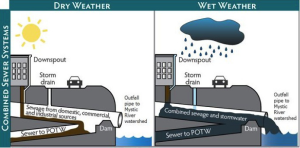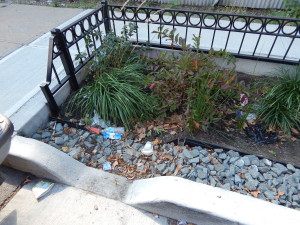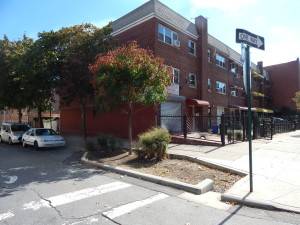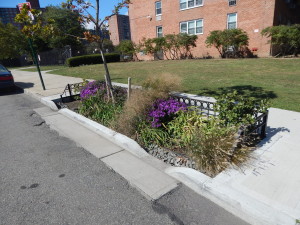Bronx environmental activists will meet this month to generate community interest in preventing the Bronx River from lapsing into its former life as a massive sewer.
Although the city’s Department of Environmental Protection (DEP) spent the last couple years constructing structures to help keep the river clean, local activists charge the agency is neglecting crucial maintenance. They claim the city’s narrow approach to keeping pollution at bay and its limited attempt to engage local residents handicaps its long-term goal.
Robin Kriesberg, the Ecology Director at the Bronx River Alliance, said via email that although DEP supports a maintenance crew, “that will not be enough” to support the immense number of implemented and planned structures.
Jaime Stein, a visiting assistant professor at the Graduate Center for Planning at Pratt Institute said the city’s outreach to the public is “too little and too late.”
It took activists more than a decade to pressure the city to install a system that would keep storm water from overwhelming local sewers and sending waste into the river. In 2012, the DEP installed the first of a dozen bioswales – highly absorbent patches of green space on sidewalks that soak up heavy rainfall. Typically about ten feet by four feet in size, they feature thirsty plants like summersweet clethra and swamp milkweed. They look more like mini-parks than like sewage devices and thus double the advantage they bring to urban areas.

Storms can force sewer waste into waterways (New York City Atlas)
Bioswales extend five feet beneath their surface. Layers of absorbent soils and stones underneath the bioswale store around 2,244 gallons of water during a storm, which is equivalent to about 45 bathtubs of water.
Although effective if properly maintained, bioswales quickly become useless when neglected, which is precisely what worries Bronx activists. As global climate change increases the likelihood of storms, controlling flooding, they say, is more urgent than ever in a city that has yet to comply with the Clean Water Act of 1972.
Storms often wash away a bioswale’s soil; left unattended, it will not be able to retain as much water. If its plants are not watered during dry spells, they will vanish and leave the bioswale feeble. Weeds and offending plants like mugworts, dandelions, and ground ivy can also decrease efficiency. If excess leaves and trash collect in a bioswale, they clog up it, rendering it useless.

Trash collected in a bioswale on Story Avenue by Colgate Avenue in Soundview (ELIZABETH GOLDBAUM/THE BRONX INK)
Caretakers must be able to identify plant species, remove weeds, clear out trash, ensure soil has not been washed away, check vegetative health, and add water during dry spells.

A dry bioswale on the corner of Metcalf Avenue and Gleason Avenue in Soundview (ELIZABETH GOLDBAUM/THE BRONX INK)
The DEP claims it funds gardeners from the Department of Parks specifically to take care of the bioswales. But activists and academics working with nonprofit organizations like Stormwater Infrastructure Matters Coalition (SWIM) doubt that the city can meet needs in light of its aggressive construction schedule. Though the city does not provide a precise account of how many bioswales it has installed, the 2013 DEP NYC Green Infrastructure Annual Report states that in the Bronx River Watershed between 2010 and 2013, it built 18 green infrastructures (which includes bioswales as well as raingardens, permeable pavements, stormwater harvesting and reuse systems, among other devices.) DEP is planning to build 57 more in 2014.
The Bronx River Alliance’s Kriesberg said she is unsure how the city will handle maintenance at this rapid rate of installation – a 217 percent increase over the last three years.
SWIM member Stein said the lack of community involvement in the city’s initial discussions on stormwater management, which would have boosted bioswale upkeep, will hinder future maintenance.
One longtime resident of Soundview in the Bronx, Nancy Reyes, 50, said she thinks the city is “trying to do a good thing” with the three bioswales she passes on the corner of Morrison and Lafayette as she makes her way into Soundview Park. But, the former customer service representative said, she “got no information” during their construction.
Her neighbor, Raquelle James, 51, a former employee of the Board of Education, said that the city needs news coverage from local stations to promote green infrastructure. Reyes and James want to know more but Reyes bemoaned they “don’t know where to begin.”
Peter Antonio, 44, a retired Soundview resident, said he “doesn’t know what’s going on,” with the bioswales next to Soundview Park, even though he often walks by them.
The Bronx River Alliance’s Kriesberg said that she is “hoping that DEP will install signs to let people know what is going on” wherever bioswales are placed.
Antonio expressed a desire to attend bioswale information workshops and would be interested in helping to maintain them – if he finds out about them.
The DEP began its “BioswaleCare Program” along with “Million Trees New York City” in the spring of 2013, after many bioswales had already been built. Only 77 community members participated in BioswaleCare workshops in 2013. Announcements of workshops are posted on the DEP’s website, which draws an audience of people already aware of the program.
Kriesberg said that attendance at past public meetings was low. She expects DEP will do more to attract the public – it is now offering free water bottles at meetings in Flushing Bay.
Even with a reliable and sufficient maintenance crew, the bioswales alone might not be enough to stave off river contamination in a storm, however. Kriesberg said, “The models and results so far indicate that the approach will have to be expanded beyond bioswales.”
Stein, an environmental activist with SWIM, said that implementing multiple bioswales within a short period of time is too narrow an approach. The bioswales are limited by available public sidewalk space. Once the sidewalks are filled, Stein asks, what will the city do?
Stein compared the bioswale plan to the city’s Million Trees initiative, which intended to plant oxygen-producing trees throughout the South Bronx to improve air quality. Good in theory, Stein said, but “there was not enough space for a million trees.” In addition, many of the planted trees were neglected and are now dead.
“The city won’t pay for maintenance,” said Soundview resident Patrick Holms, a 43-year-old accountant who lives near two bioswales on Morrison Avenue. Without information, “the community won’t get involved” to maintain the bioswales, he warned. Holms recommended that Bronx Borough President Rubin Diaz, Jr. speak out on bioswale maintenance. “If he made appearances, more people would care,” Holms said
DEP representatives did not respond by press time to repeated requests for comments.
Stein and members of SWIM are looking forward to the public meeting on October 27 to engage public officials, scientists, attorneys, representatives of nonprofits, and city agencies in the discussion on stormwater management in the face of rising temperatures and precipitation. They are hoping, too, that the meeting will be an occasion for involving the community in protecting its river.
Phil Pena, a letter carrier who has “been around a few years,” passes two bioswales on Gleason Avenue on his delivery route in Soundview. He said, “The city is trying to make the sidewalk look good.”
After finding out that they capture stormwater, he said that the city should have installed one on Metcalf Avenue, between Gleason and Watson Avenues. “The sidewalk gets flooded every time it rains,” he said. “Nobody talks about it,” and “I’ve got to walk in the street.”


Why doesn’t the BRA work w/the DEP to establish an AaB (‘Adopt a Bioswale’) program?